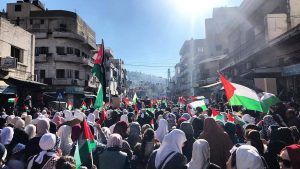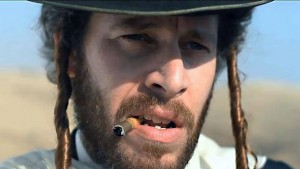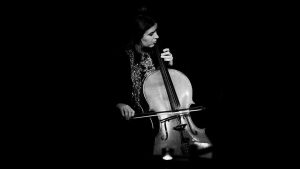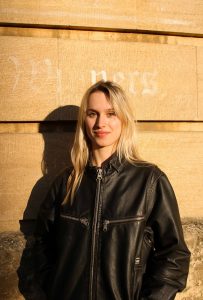
Art on the Seam: Jerusalem’s street art movement
by Naomi Polonsky | February 23, 2015
“Art has a very significant role in changing the reality in Israel. We need a much more creative atmosphere to find a creative solution for the problems here”. Matan Israeli, a 35-year-old Jerusalemite is the founder and artistic director of the Muslala project, which was set up in Jerusalem, in 2009, by a group of young Jewish and Palestinian artists. The project takes its name in part from the neighbourhood, Musrara, in which it is based. Nowhere are the inescapable tensions and natural beauty of Jerusalem more perfectly combined than in this little neighbourhood, which lies at the heart of the ancient city, on the seam between the East and West parts. Comprising just a few streets, Musrara possesses a serenity that belies Jerusalem’s tumultuous history and tortured present. Ethnic tensions cling to the neighbourhood as firmly as the bougainvillea clings to its butter-coloured walls. The two intifadas deepened enmities and the biennial Palestinian-Israeli wars keep them alive. Musrara is a demographic microcosm of Israel, with a Palestinian part and a Jewish part made up of ultra-orthodox and secular inhabitants. These different groups co-exist but are highly self-segregating.
Matan lived in Musrara for over a decade before founding the project. “I became interested in doing this when I discovered that I was living in such an interesting neighbourhood. It’s not just a neighbourhood, it’s a piece of history — on-going, changing, fascinating. Art deserves to be a part of that.” Musrara’s history dates back to the turn of the twentieth century when a group of Arab Christians decided to leave the overcrowded Old City. Settling outside the Old City walls, they built themselves luxurious houses with arched entrances, pale blue shutters and shingled roofs, punctuated by fertile gardens. During the 1948 Arab-Israeli War, Musrara’s wealthy Arab residents fled these plush homes and the end of the war left the neighbourhood divided, like the rest of the city, between the Israeli West and the Jordanian East. The Israeli government used the abandoned mansions to house the new waves of immigrants, mainly Mizrahi Jews (from the Middle East and North Africa). Straddling the seam between East and West Jerusalem, the neighbourhood became a no-man’s land. To protect against military attacks many houses became makeshift fortresses, lined with cement and sandbags. Each house was inhabited by multiple large families and many fell into disrepair and neglect.
After the reunification of Jerusalem in 1967 the neighbourhood began to recover from its war-torn days. However, ethnic tensions persisted, not only between Israelis and Palestinians but also between Israelis of Mizrahi and Ashkenazi (European) descent. In 1971, the Israeli Black Panther movement was born. Named as a tribute to its African American counterpart, the Panthers were a group of second-generation Mizrahi immigrants. They organised demonstrations, sometimes violent, in protest at the discrimination against Mizrahis within Israeli society — playing a significant role in improving the social and political conditions for Mizrahis in Israel.
It is against this backdrop of social discord and ethnic tension that the Muslala project emerged. The group of young artists are attempting to create a model that, in the words of their mission statement, ‘combines artistic activity with a social orientation’. Works of urban art abound. A pair of mysterious painted figures paces across the surface of a garage door. A self-satisfied caterpillar counting his money and a woeful mouse drinking a bottle of wine adorn the wall of tall house. The church noticeboard is the setting for an ever-evolving collage, painted by artists and locals alike.
The Black Panther sign – an upturned black fist – appears in various places around the neighbourhood. The Muslala group has also named a couple of streets in homage to the Panthers: ‘Black Panthers Way’, and ‘They’re Not Nice Alley’ (from then-Prime Minister Golda Meir’s famous pronouncement on the Israeli movement after meeting them in the seventies). Though the Panthers strongly divide opinion, for the Muslala artists they are folk heroes, icons of social justice in a country increasingly polarised between left and right. “The Panthers were a radical voice for equality,” Matan explains. “What the Panthers were fighting for hasn’t changed here. This is a chance to revive them.” These works are subtle: the Panther fists are always very small and the street signs look like any other municipal markers until you peer more closely.
The same is true of a small spray-painted arrow, modelled on the common marker, which points residents to the מקלט (miklat – bomb shelter). Next to it lies a second arrow, which directs to אהבה (ahava – love). As Matan explains, the juxtaposition also directs to uncomfortable questions: “Which one is more important? Which one leads to safety?” The bomb shelter – an underground bunker – used to be Muslala’s base, comprising an office and a couple of workshops, until it had to be evacuated during the war of summer 2014 to serve its original purpose. The Muslala artists’ main current project is setting up a new base, in a building in the centre of Jerusalem. Rather than being a setback, this move is a chance for the project to expand, in a space which, according to Matan, will be “bigger and better”. “Opening a new centre is a work of art in itself,” he chuckles.
Some works of art serve a practical use. ‘Chiara’s Staircase’ was built by Matan for his Italian girlfriend Chiara, who lived in the lower Old City, so that she could scale the wall into the elevated neighbourhood when she wanted to see him, saving her a twenty minute detour. The wooden staircase was dismantled during the Second Intifada, and has now been replaced by a more sturdy metal structure. Matan and Chiara’s romance may have ended, but this bridge across no man’s land – literal and metaphorical – endures. Palestinian artist Hannan Abu Hussein created a bench embedded with everyday objects, such as stockings and condom wrappers. In a city where there are deeply ingrained religious sensibilities, the presence of these sexually suggestive objects is provocative. Yet, paradoxically this provocation brings the segregated groups together by kind of negative cohesion.
Among all the many different works of street art, one piece of Banksy-esque graffiti particularly stands out. A little child stands, looking up at the sky. A silhouetted shape casts a shadow on its infant observer. The shape could be a kite or it could be something much more sinister. The ambiguity is haunting. The reality for Israeli and Palestinian children is that a shape hovering in the sky is just as likely to be a missile as it is a kite. As you walk down the streets of Musrara you are made to realise these sad truths.
‘The Meeting Point’, a large circular clay sculpture with a conglomeration of different prints from around Jerusalem, is the work of Peter Maltz, a sculpture teacher at Jerusalem’s Bezalel Art School and a collaborator on the Muslala project. “In order to create the sculpture I published a notice in Jerusalem, inviting twelve people to take part in the creation of the sculpture”, he explains. “Each participant chose a spot to copy in Jerusalem. The technique was simple: pressing clay to the area.” ‘The Meeting Point’ is a meeting of imprints from different parts of Jerusalem. It also fosters meeting between people. It lies in the community garden, a plot of disused land, which the Muslala group has turned into an outdoor exhibition space. Peter personally cleared up the previously wild plot of land. He tells me how he had to make an urgent trip to the doctor after he was pricked by a needle that was potentially HIV-ridden.
This community garden forms the setting for Muslala’s annual festival ‘Between Green and Red’. This five-day event resurrects the watermelon stands (basta – سطة) that the Black Panthers used as meeting places and open salons during the seventies. These vast wooden structures brought together the separate factions of Musrara, becoming spontaneous neighbourhood hangouts, where people would listen to music and watch Kung Fu films. The Muslala group is trying to recreate this meeting point, by putting on a string of cultural events and selling watermelon. Watermelon, with its vivid clashing colours, is a powerful symbol. But more importantly it is a fruit that must be shared; no one eats watermelon alone.
At the first of these watermelon festivals in 2012, emotions got the better of some participants, ending in a group of Palestinian youngsters being accused of harassing Israeli Jewish girls. There has been other adversity to the project’s mission: several works of street art – a billboard that featured a painting of a woman and a large graffiti sign that read “Help!” – were defaced or painted over by enraged local residents. But there has also been considerable support and success. “The big success is that we work as a group”, says Matan, revealing much about the project’s underlying philosophy. In a country where peaceful co-existence can be hard to imagine, Musrara provides creativity, expression and hope.




